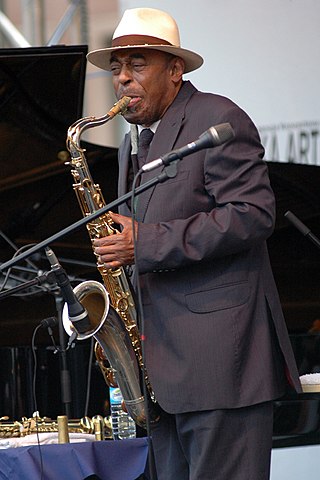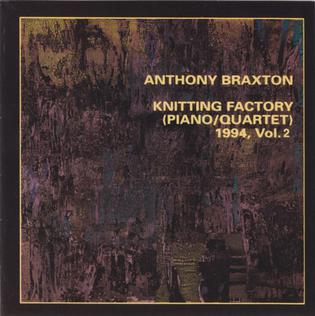
The saxophone is a type of single-reed woodwind instrument with a conical body, usually made of brass. As with all single-reed instruments, sound is produced when a reed on a mouthpiece vibrates to produce a sound wave inside the instrument's body. The pitch is controlled by opening and closing holes in the body to change the effective length of the tube. The holes are closed by leather pads attached to keys operated by the player. Saxophones are made in various sizes and are almost always treated as transposing instruments. Saxophone players are called saxophonists.

Bebop or bop is a style of jazz developed in the early-to-mid-1940s in the United States. The style features compositions characterized by a fast tempo, complex chord progressions with rapid chord changes and numerous changes of key, instrumental virtuosity, and improvisation based on a combination of harmonic structure, the use of scales and occasional references to the melody.

John William Coltrane was an American jazz saxophonist, bandleader and composer. He is among the most influential and acclaimed figures in the history of jazz and 20th-century music.

Eric Allan Dolphy Jr. was an American jazz alto saxophonist, bass clarinetist and flautist. On a few occasions, he also played the clarinet and piccolo. Dolphy was one of several multi-instrumentalists to gain prominence in the same era. His use of the bass clarinet helped to establish the instrument within jazz. Dolphy extended the vocabulary and boundaries of the alto saxophone, and was among the earliest significant jazz flute soloists.

Albert Ayler was an American avant-garde jazz saxophonist, singer and composer.

Gerald Joseph Mulligan, also known as Jeru, was an American jazz saxophonist, clarinetist, composer and arranger. Though primarily known as one of the leading jazz baritone saxophonists—playing the instrument with a light and airy tone in the era of cool jazz—Mulligan was also a significant arranger working with Claude Thornhill, Miles Davis, Stan Kenton, and others. His piano-less quartet of the early 1950s with trumpeter Chet Baker is still regarded as one of the best cool jazz groups. Mulligan was also a skilled pianist and played several other reed instruments. Several of his compositions including "Walkin' Shoes" and "Five Brothers", have become standards.

Henry "Hank" Mobley was an American hard bop and soul jazz tenor saxophonist and composer. Mobley was described by Leonard Feather as the "middleweight champion of the tenor saxophone", a metaphor used to describe his tone, that was neither as aggressive as John Coltrane nor as mellow as Lester Young, and his style that was laid-back, subtle and melodic, especially in contrast with players like Coltrane and Sonny Rollins. The critic Stacia Proefrock claimed him "one of the most underrated musicians of the bop era." Mobley's compositions included "Double Exposure," "Soul Station", and "Dig Dis," among others.

Archie Shepp is an American jazz saxophonist, educator and playwright who since the 1960s has played a central part in the development of avant-garde jazz.

Charles Edward Haden was an American jazz double bass player, bandleader, composer and educator whose career spanned more than 50 years. Building on the work of his predecessor bassists Jimmy Blanton and Charles Mingus, Haden revolutionized the harmonic concept of bass playing in jazz, evolving a way of playing that sometimes complemented the soloist, and sometimes moved independently, to help liberate bass players from a strictly accompanying role, to becoming more direct participants in group improvisation.
The term "M-Base" is used in several ways. In the 1980s, a loose collective of young African American musicians including Steve Coleman, Graham Haynes, Cassandra Wilson, Geri Allen, Robin Eubanks, and Greg Osby emerged in Brooklyn with a new sound and specific ideas about creative expression. Using a term coined by Steve Coleman, they called these ideas "M-Base-concept" and critics have used this term to categorize this scene's music as a jazz style. But Coleman stressed "M-Base" doesn't denote a musical style but a way of thinking about creating music. As famous musicians did in the past, he also refuses the word "jazz" as a label for his music and the music tradition represented by musicians like John Coltrane, Charlie Parker, Louis Armstrong, etc. However, the musicians of the M-Base movement, which also included dancers and poets, strived for common creative musical languages, so their early recordings show many similarities reflecting their common ideas, the experiences of working together, and their similar cultural background. To label this kind of music, jazz critics have established the word "M-Base" as a jazz style for lack of a better term, distorting its original meaning.

Malcolm Earl "Mal" Waldron was an American jazz pianist, composer, and arranger. He started playing professionally in New York in 1950, after graduating from college. In the following dozen years or so Waldron led his own bands and played for those led by Charles Mingus, Jackie McLean, John Coltrane, and Eric Dolphy, among others. During Waldron's period as house pianist for Prestige Records in the late 1950s, he appeared on dozens of albums and composed for many of them, including writing his most famous song, "Soul Eyes", for Coltrane. Waldron was often an accompanist for vocalists, and was Billie Holiday's regular accompanist from April 1957 until her death in July 1959.
Joseph Arthurlin Harriott was a Jamaican jazz musician and composer, whose principal instrument was the alto saxophone.

Marc Copland is an American jazz pianist and composer.
Salvatore Nistico was an American jazz tenor saxophonist.
Gerald Danovitch was a Canadian classical saxophone player and educator, McGill University professor, founder of Gerald Danovitch Saxophone Quartet and jazz studies department at McGill.
Mat Walerian is a jazz saxophonist and woodwind player, composer and bandleader who specializes in improvisation and avant-garde music.

Adventures in Jazz is an album by the Stan Kenton Orchestra, recorded in late 1961 but not released until about a year later in November 1962. The album won a Grammy Award in the category for Best Jazz Performance – Large Group (Instrumental) category in 1963. This would be Kenton's second Grammy honor in as many years with the first being Kenton's West Side Story winning the Best Large Jazz Ensemble Album in 1962. Adventures In Jazz was also nominated for Best Engineered recording for the 1963 Grammys. The 1999 CD re-issue of Adventures In Jazz is augmented with two alternate takes from the original recording sessions and one track from Kenton's release Sophisticated Approach.

Martin Uherek, is a jazz saxophonist from Slovakia.
Lawrence "Larry" Stephen Porter is an American jazz musician and composer.

Knitting Factory (Piano/Quartet) 1994, Vol. 2 is a live album by composer and pianist Anthony Braxton with a quartet, recorded at the Knitting Factory in 1994 and released on the Leo label in 2000.














